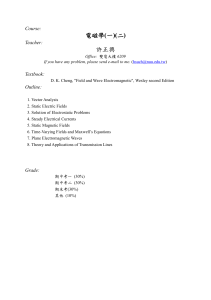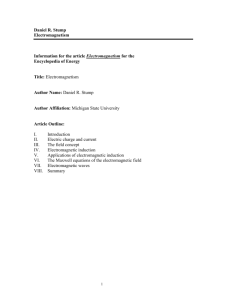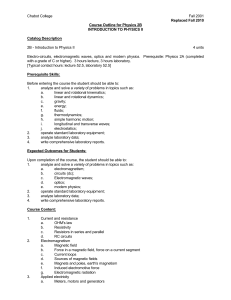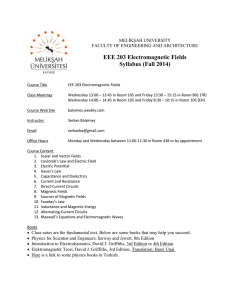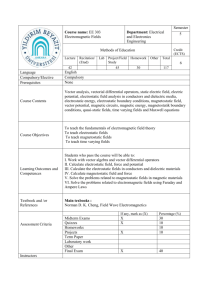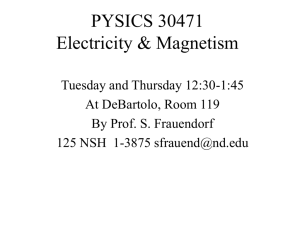Scope of this Course Electromagnetism
advertisement
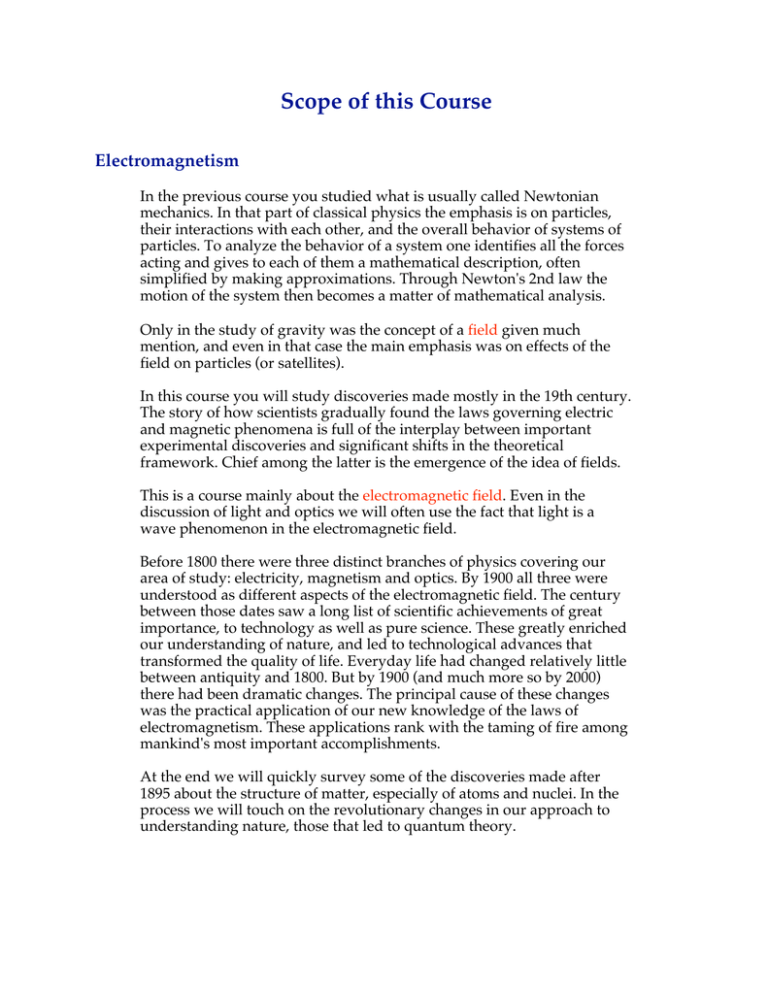
Scope of this Course Electromagnetism In the previous course you studied what is usually called Newtonian mechanics. In that part of classical physics the emphasis is on particles, their interactions with each other, and the overall behavior of systems of particles. To analyze the behavior of a system one identifies all the forces acting and gives to each of them a mathematical description, often simplified by making approximations. Through Newton's 2nd law the motion of the system then becomes a matter of mathematical analysis. Only in the study of gravity was the concept of a field given much mention, and even in that case the main emphasis was on effects of the field on particles (or satellites). In this course you will study discoveries made mostly in the 19th century. The story of how scientists gradually found the laws governing electric and magnetic phenomena is full of the interplay between important experimental discoveries and significant shifts in the theoretical framework. Chief among the latter is the emergence of the idea of fields. This is a course mainly about the electromagnetic field. Even in the discussion of light and optics we will often use the fact that light is a wave phenomenon in the electromagnetic field. Before 1800 there were three distinct branches of physics covering our area of study: electricity, magnetism and optics. By 1900 all three were understood as different aspects of the electromagnetic field. The century between those dates saw a long list of scientific achievements of great importance, to technology as well as pure science. These greatly enriched our understanding of nature, and led to technological advances that transformed the quality of life. Everyday life had changed relatively little between antiquity and 1800. But by 1900 (and much more so by 2000) there had been dramatic changes. The principal cause of these changes was the practical application of our new knowledge of the laws of electromagnetism. These applications rank with the taming of fire among mankind's most important accomplishments. At the end we will quickly survey some of the discoveries made after 1895 about the structure of matter, especially of atoms and nuclei. In the process we will touch on the revolutionary changes in our approach to understanding nature, those that led to quantum theory. The Electrostatic Field Our description starts with the electrostatic field, which involves electric phenomena affecting bodies more or less at rest. This field is much like gravity, with the important difference that electric charge (unlike mass) can take on either positive or negative values, so the fundamental force can be either an attraction (like gravity) or a repulsion. Like gravity, the electrostatic force is conservative, so we define its potential energy. An important auxiliary scalar field called electrostatic potential is introduced. As always, energy is of prime importance in our understanding of things. We will discuss the energy in the electrostatic field, especially in terms of capacitors which store it. Currents and Circuits The flow of electric charge called current is described, and practical arrangements using that flow in a controlled way, called circuits, are discussed. At first only currents constant in time are considered. Later, time-dependent currents are analyzed, especially those that oscillate sinusoidally. The Magnetic Field The magnetic field, as it affects individual moving charged particles or currents in circuits, is described next. Then we discuss the way in which a current acts as the source of a magnetic field. The magnetic properties of materials are not treated in detail because a serious discussion of that subject necessarily involves quantum theory. Electrodynamics Up to this point, the fields are assumed to be independent of time, and act independently of each other. When time-varying fields are considered, remarkable new phenomena appear, linking electricity with magnetism. The first of these is the induction of a current — or more fundamentally an electric field — by a time-varying magnetic field. There is also a corresponding induction of a magnetic field by a time-varying electric field. In combination, these phenomena make possible transport of energy and momentum through empty space by means of electromagnetic waves . The description of electromagnetism is now complete, embodied in the famous equations put forward by Maxwell, plus the equation due to Lorentz describing how the fields act on a single charged particle. Optics Systematic study of light dates back at least to the 17th century, but only in the 19th did it become clear that light is a particular type of electromagnetic wave. Our discussion begins with the approximation called "ray" optics, which is based on the fact that the wavelengths of visible light are very small by human standards. This subject includes analysis of reflection and refraction at interfaces between two media, and deals with formation of optical images by devices, such as mirrors and lenses, using these phenomena. Then we study those phenomena specifically exhibiting the electromagnetic wave properties of light, including polarization, interference and diffraction. Atomic and Nuclear Physics The course closes with a brief discussion of atomic and nuclear physics, surveying some of the discoveries made in the 20th century about the microscopic world. Although atoms and molecules were assumed to exist by most scientists (especially chemists) in the 19th century, direct evidence for them came only at the end of that century. The discovery of the electron in 1897 began a century of exploration of the structure of these objects. A major breakthrough was the discovery in 1911 of the atomic nucleus. It was clear early on that the rules of classical physics could not adequately deal with these microscopic systems. By the end of the 1920's a new framework, quantum mechanics, was developed that seems to provide the appropriate theoretical basis. Soon many of the mysteries of atomic structure were being explained. We will discuss a few of these. In the1930's the structure and properties of the nucleus came under intense investigation. Some of the processes peculiar to the nucleus, such as radioactivity, have great importance in modern medical practice. We will discuss a few of these properties.
